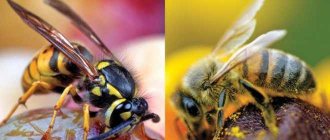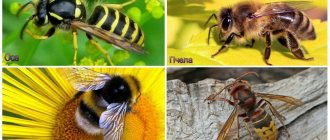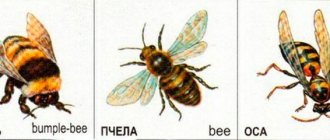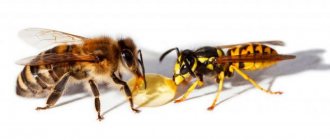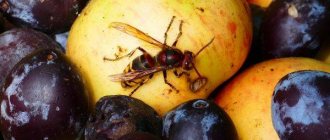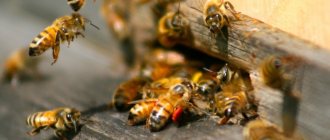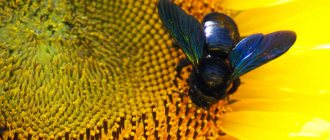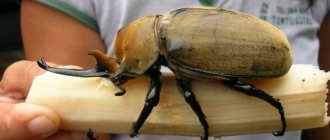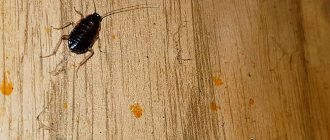Wasp, bee, bumblebee and hornet - everything you need to know about stinging insects. External descriptions and differences. Where they live and how they build nests. What do they eat and who is the hunter? How dangerous are they for humans? Why is the disappearance of these stinging representatives dangerous? Features of insects and benefits for people.
The most common insects include wasps, bees, bumblebees and hornets, which we can encounter not only when traveling in nature, but also in the city. To understand these insects we need to get to know them better, then we can easily learn to distinguish them.
Some consider them very dangerous, because when they bite they release poison, which is very difficult for the human body to perceive. Let's consider what similarities and differences a wasp, a bee, a bumblebee and a hornet have, what benefits they bring and why they are dangerous.
How to distinguish insects
If you are far from entomology, but care about the preservation of beneficial bees, then it is enough to know the most striking visual differences. In flight, these signs are impossible to catch, but in a calm state they are striking:
- Coloring. The differences are significant. The insects are striped, but the intensity of color and their contrast are more pronounced in the wasp. It will have more elegant colors. Bright, sunny yellow stripes mixed with black. Bees are more modest. Their yellow is calm, muted, the transition is less contrasting. Individual representatives of the families have white or brown colors in their arsenal.
- Villi. Bees are focused on pollination. Therefore, they are covered with clearly visible fluff - special villi for the transfer of pollen. You wouldn’t suspect a wasp of such hard work: its abdomen is bare, even glossy.
- Wasps are elongated. They can even be called elegant. Bees are more rounded and dense.
If you look really biasedly, you will definitely see lumps of pollen on the bees’ legs.
They also differ in their habitat. If you find a nest, the wax honeycombs point directly to the bees. Wasps build them from clay, plant debris, and wood.
Coloring
The coloring options for insects are so numerous that it is not difficult to distinguish between a bumblebee, a wasp and a bee. The bee is distinguished by dark brown shades. In cartoons, there is a certain stereotype, which is why honey collectors are drawn with stripes. If you look closely at the images of insects, their difference immediately catches your eye.
Bumblebees and wasps can have completely monotonous colors, including stripes. There are glossy wasps, which are distinguished by rainbow colors, and typhias, for example, are painted in a monotonous black color. However, most people believe that wasps have exclusively classic colors, with a predominance of yellow and black stripes. It should be noted that representatives of other families that do not have similar coloring can be dangerous and can bite just as painfully.
Who bites harder?
The greatest aggression is inherent in hornets and wasps, which have a thin sting - they can use it a couple of times, while deeply piercing the skin. The bites are painful and burning, and the site of the attack becomes severely swollen. There is also a risk of causing an allergic reaction. Do not forget that the wasp gives a signal, so you may encounter a whole swarm of insects that continue to exist after being bitten.
It is more difficult to anger bees, but the sting remains in the wound. They can attack only once, as a result the bee will die. The blow is delivered only when there is great danger. The bites are not very painful.
Bumblebees are considered the most benevolent and can attack only in exceptional cases. The bites are also not very painful. Only the female has a sting; when bitten, it does not remain in the affected area of the skin. Severe allergies and increased body temperature may occur. Bites are very dangerous for children.
Read further:
Bee, wasp, bumblebee and hornet - description, differences in appearance, behavior, lifestyle
Wasp, bee, bumblebee and hornet: what are the similarities and differences between these insects
Hornet and wasp - who stings more, consequences of a bite, allergic reaction, first aid after an attack
How is a wasp different from a bee: description, appearance, lifestyle, behavior, bites, danger
Nature of the bites
The wasp stings are much more painful, but the nature of the bites has its own similarities.
As mentioned above, wasps can sting several times. At the same time, there is a risk of infection, since wasps often visit places where there is complete unsanitary conditions. As for the bee, the sting is not so dangerous, since the only thing bees do is collect nectar from flowers - honey plants.
Every person should be able to provide first aid for wasp and bee stings. Ignorance of these rules, as well as illiterate actions, can harm human health. This is especially true for people prone to allergies, young children, expectant mothers and people with poor health.
As a result of a bee or wasp sting, the following characteristic signs appear:
- Swelling of the bite site.
- Redness.
- Severe throbbing pain.
- Deterioration in health.
In cases where the human body is hypersensitive, the reaction may be as follows:
- The swelling increases, the tissues of the larynx, tongue and facial area swell.
- Breathing problems appear: attacks of suffocation are possible.
- The heart begins to beat much faster.
- Redness spreads over a significantly larger area of the body.
- There may be an increase in body temperature or cold sweat.
- The person develops a feeling of anxiety.
Anaphylactic reactions occur if the degree of intoxication of the body is more severe:
- The man loses consciousness.
- Hemorrhages in the eye area.
- The person's skin becomes pale.
- The pulse is barely palpable or is 100 beats per minute, or even more.
- The pressure is either high or low.
- Trouble breathing, the victim can barely breathe.
- Tachycardia develops.
- Painful sensations appear in the abdomen and breasts.
- The wound is very itchy.
- Nausea and dizziness may occur.
When to seek help from doctors
You should immediately call an ambulance if:
- In cases of multiple bites.
- When anaphylactic reactions occur.
- When a person is prone to allergies, but does not have the necessary medications at hand.
- When an insect bites the tongue, face or eye area.
- If the victim is a child or an expectant mother.
First aid rules
- Take the victim away from the place where he was bitten by a wasp or bee to a safe place.
- If a bee has bitten you, remove the sting using tweezers, moistening it with alcohol or cologne.
- The bite site is wiped with cold water or another disinfectant solution.
- If this happens far from home, in nature, then the bite site is washed with clean water, after which a plantain or dandelion leaf is applied to the bite site, which also needs to be washed with clean water.
- A cold compress is applied to the wound to relieve discomfort and itching.
- The bite site is treated with drugs such as Fenistil-gel, Rescuer balm, etc. It is possible to use folk remedies such as aloe juice, chopped parsley and others.
- The victim should take an allergy pill.
- Give the victim regular, mineral or bottled water without gas to drink to quickly remove toxins from the body.
What not to do about bee and wasp stings
Many people misunderstand this situation, which can cause serious damage to the human body. As a rule, a person is overcome by panic and, as a result, wrong actions that can lead to negative consequences.
So, what not to do:
- Squeeze out the sting or venom.
- Cauterize the bite site.
- Rub the affected area.
- Smoking.
- Drink alcohol.
- Move actively.
- Be in direct sunlight.
You can't just lie there. An acceptable option is a half-sitting position. In this position, the load on the heart is minimal, and in case of vomiting, the person cannot be harmed.
It is not at all difficult to distinguish a bee from a wasp. If we talk about benefits, then the bee brings more benefits, although wasps also have their purpose and take their place in the ecosystem. It is wrong to say that wasps are useless insects. Both will bite if you anger them or interfere with their living space. If you do not provoke insects, they will not attack humans. Sometimes it is the person himself who is to blame for being bitten by insects. For some reason they think they won't get hurt.
Under certain conditions, both a wasp and a bee can bite. In such cases, you need to know what to do. In most cases, when the human body reacts adequately to insect bites, the bites go away on their own. The only problem is children who can scratch the bite site and then secondary infection is possible, as well as people prone to allergies. However, they should always have antihistamines with them. The main thing in such a situation is not to get confused, otherwise unpredictable consequences are possible.
Loading…
Insect bites
Sources
- https://BeetleStop.ru/kak-otlichit-osu-ot-pchelyi/
- https://parazitam-stop.com/nasekomye/osy/otlichie-ot-pchely.html
- https://KlopSOS.ru/osy-i-shershni/chem-otlichaetsya-osa-ot-pchely-i-shmelya-i-kak-ne-pereputat-etih-nasekomyh/
- https://dachadizain.ru/zhivotnye/chem-osy-otlichayutsya-ot-pchel.html
- https://eparazit.ru/otlichie-osy-ot-pchely.html
- https://prusakam.net/chem-otlichaetsya-pchela-ot-osy/
Wasp and man
Given their aggression, a person from early childhood acquires intolerance to these Hymenoptera, since everyone is bitten almost every year. Summer residents and gardeners who relax and work in the fresh air often encounter this insect.
Application in medicine
Wasps in some cases can not only cause harm, but also benefit humans. In folk medicine, abandoned wasp nests, which are completely sterile inside, have been used. An alcoholic infusion of them perfectly treats joint and bone diseases; a decoction of the powder has a beneficial effect on stool and the functioning of the gastrointestinal tract. Also, powder or infusion is used for taking baths, which improve muscle tone and give lightness to the body.
Danger to humans
Urban wasps, being a constant companion of a person, can bring him a mortal threat. Representatives of this species are capable of attacking not only singly, but when the nest is threatened, even in groups of several dozen.
Their bites are extremely painful and cause severe allergies. Why they are so aggressive in ordinary everyday situations is difficult to understand.
In summer and autumn you need to be extremely careful, as these insects are everywhere. It is especially worth keeping an eye on children - their reaction to a bite can be extremely severe. You can accidentally put an insect with a grape, a piece of watermelon, or a glass of drink into your mouth.
- allergy;
- hypertension or hypotension;
- temperature increase;
- dizziness, nausea, vomiting, diarrhea;
- loss of orientation in space;
- convulsions;
- swelling of the larynx;
- death.
Formation of nests
Real bees and their families build nests in a hive or in another place if a ready-made hive is not available. Their nests consist of honeycombs that have a regular shape, in contrast to the nest itself, which can have any shape. The shape of the nest depends on the shape of the cavity in which the bees build their nest.
As for wasps, they build nests on their own in any suitable place. As a rule, wasp families are not as numerous as bee families, so their nests are not large. Mostly, wasp nests are found in the form of an elongated top or in the form of a curved plate of irregular shape. If you look at this plate, it resembles a sunflower, but without seeds.
Wasps build nests from cellulose glued together with their saliva. If you pick up the nest, it resembles an object glued together from thick cardboard.
To whom will the hornet yield in battle?
By analogy with previous connections between hornets, we can also identify those who are more likely to be the aggressor in relation to this insect.
The relationship between winged predators and spiders stands apart from all others.
Spider vs hornet
Hornet vs Tarantula Spider has an average chance of winning. These rivals have approximately the same body size, but the spider’s body, among other things, is equipped with strong venom and very powerful chelicerae. Therefore, in this skirmish the one who bites first will win.
The hornets' closest relatives - large road wasps and wandering ants - can also be formidable rivals.
One of the most original biological enemies of hornets is a unique fungus that develops in the insect’s brain.
The spores of this fungus enter the hornet's body through the mouth or respiratory tract and germinate in its head. During its development, the mycelium secretes special substances that cause the insect to feel constant thirst.
Willy-nilly, driven by instinct, the hornet looks for a suitable place to drink, and here the developing killer mushroom causes paralysis in the insect. The victim freezes in a completely unexpected position - for example, hanging on a blade of grass.
At the last stage of its life cycle, the parasite releases a fruiting body, thereby spreading new spores in a humid environment favorable for this process. Thus, a predatory insect, by its death, gives life to another, albeit such an ambiguous, living organism. Entomologists often find wasps and hornets with dried fungal bodies protruding from their heads.
Hornets also have enemies among vertebrates.
Some other insectivorous birds can also feed on hornets in a similar way. But among mammals, the only one that is definitely dangerous for this insect is a person who has learned to destroy not only individual wasps, but also their nests without much difficulty.
However, most often hornets die not from the “hands” of opponents worthy of strength, but from small parasites - mites, nematodes and riders, which cannot be destroyed.
So it is with the hornet: there are objects that it eats, acting as a formidable killer, and there are also those that destroy it, not paying any attention to the full power of this insect’s biological weapons.
Properties of the sting
Indian scientists, together with colleagues from Ohio State, conducted research and determined that wasp and bee stings were not created so simply. There are differences between them:
- curved in a wasp;
- direct from the bee.
Both insects have two movable barbs at the end, sharp as a dagger. They make it easier to pierce the body surface.
Using equipment, scientists discovered a feature in both stings - the presence of voids, due to which the sting is light but durable.
wasp sting
Bee sting
An important discovery was that the stings at the base are less elastic and soft than those at the top. Because of this, the sting enters the skin painlessly; the insect has time to inject poison before the person feels it and tries to shake it off.
Studies have also shown that insects bite at an angle, which is why the sting remains strong for a long time.
On the other hand, the bee cannot remove the sting because it has serrations and part of the intestine breaks off, causing the insect to die.
The wasp sting is thin, curved and pointed. After injecting the poison, the insect easily pulls it out.
The composition of the toxic substance varies among different types of wasps. But only females sting, since their sting (in addition to their weapon) is an ovipositor.
Huge Asian hornet (Vespa mandarina japonica).
It is no longer than a finger in size, however, this creature is capable of spraying acid from its proboscis, which eats through human flesh. In addition, this hornet usually “shoots” directly into the eyes. And very accurately. It is also almost impossible to escape from it, because this little monster flies at a speed of 80 km/h. And, the most terrible detail: the venom of this hornet contains special pheromones that are “heard” by its other brothers. They quickly flock around their prey, after which it has virtually no chance of survival. Hornets kill an average of 40 people every year.
Who bites harder?
Hornets and wasps are the most aggressive; they have a thin sting with which they pierce the skin deeply several times. The bite is painful and burning, the affected area swells greatly. This may cause an allergic reaction. Wasps are also able to give a signal for the entire swarm to join them. These insects continue to live after being bitten.
It is difficult to anger a bee, but it leaves a sting in the body, striking only once, and subsequently dies. Bees sting only in extreme danger. Their bite is not so painful.
The most benevolent of all is the bumblebee; he attacks in exceptional cases. Its bite is less painful. Only the female has a sting; she does not lose it, and sometimes bites several times. A bumblebee sting can cause severe allergies and fever, and is especially dangerous for children.
Behavior
The bumblebee is different in that it prefers to fly alone, and if disturbed, it simply flies away.
A bee, even when alone, can hover around an object. He learns how dangerous this object is for him. Thus, it is unlikely to be able to sting unless it flails its arms. Bees will attack in any case if the peace of the colony or hive is disturbed.
The wasp is considered the most annoying insect and can sting in the most innocent situation. A wasp sting is characterized by sharp and severe pain.
External differences
Despite the fact that wasps and bees belong to the same order Hymenoptera and are essentially related, they have many differences
We will not take into account exotic types of flyers and consider:
- common types of paper wasps;
- honey bees;
- hornets - typical representatives of social wasps;
- bumblebees are ambassadors from the family of real bees.
Color
You can identify the difference between a bee and a wasp visually by their appearance. The color of the bee is muted yellow with black stripes. The body is covered with hairs.
The wasp is distinguished by a smooth body without signs of hair, rich yellow and contrasting black stripes. The bright “robe” of the insect is noticeable from a great distance. But the wasp does not need thick hair, because collecting nectar is not its main business.
The color of the body is one of the main signs of difference between a bee and a wasp.
Body structure
It is not for nothing that the wasp is famous for its wasp waist - the interception between the abdomen and chest. In the photo, the graceful curve is visible especially clearly. The body shape is elongated and elongated. Upon closer examination, powerful jaws and thin legs stand out.
The hornet is very similar in appearance to the wasp, but only with more developed jaws and a thicker waist.
The bee has a more rounded body and the interception between its parts is barely visible. Compared to the wasp, the proportions are harmonious. The abdomen differs in shape depending on what level the insect occupies in the bee hierarchy. In honey-bearing workers it is egg-shaped, in the queen it is elongated, and in drones it has a blunt ending. Unlike wasps, bees have so-called baskets on thick legs - containers in which they place flower nectar.
Certain blood types sting people more often
Those who smell good to mosquitoes and bumblebees are often stung. Mosquitoes are first attracted to components of human sweat. It's not just sweat, breath, or more specifically carbon dioxide that can attract mosquitoes to spy on their victims. Other odors that attract them are lactic acid, uric acid, body heat and ammonia.
This explains, for example, why athletes are more likely to be stung than other people, because they produce significantly more lactic acid during exercise. The composition of bacteria on the skin also plays an important role. Blood type 0
is the most popular according to tests by the Institute of Pest Control Technology.
How to help a victim while the ambulance is on the way
Experts from the authoritative research organization Mayo Clinic recommend Insect bites and stings: First aid to act this way.
Give adrenaline as soon as possible
Ask the stung person if he has an epinephrine auto-injector. If a person is allergic, he can have this device with him. If not, urgently send someone or run yourself to the nearest pharmacy for injection adrenaline.
The drug should be injected into the outer part of the thigh. Do not inject into a vein, gluteal muscle, leg below the knee, or arm as this may cause tissue damage.
Several injections may be needed. If after 10–15 minutes the condition does not improve and breathing difficulties, nausea, and weakness persist, administer adrenaline again.
Lay the victim horizontally
On the back or side - it doesn’t matter, as long as the person is comfortable. Remove from tight clothing and cover with a blanket, jacket, sweater
Do not give anything to drink or eat - this may cause vomiting.
If necessary, begin CPR
If the person is not breathing and/or has no heartbeat, perform mouth-to-mouth artificial respiration and chest compressions.
Appearance
Bee
The bee is distinguished by its discreet color and shaded black and yellow stripes. The body is shaggy, without a pronounced transition from the chest to the tummy, the legs are plump, black and shaggy, the jaws are small. The back is black with a yellow coating, the posterior segment of the body has dark yellow stripes. The size of the worker and the queen bee is different.
The main difference between a wasp and a bee is the presence of a waist. It has a sharp transition from the sternum to the tummy, the body itself is smooth and elongated. What distinguishes it from others is its color: in wasps it is bright and contrasting, the back is black, with yellow splashes, the rear segment of the body is striped, black and yellow. The paws are yellow, the jaws are massive.
Bumblebee
The bumblebee is many times larger and hairier than bees and wasps. It has wide red stripes on its brown body. There are also pure black bumblebees. The differences between the female and the male are the presence of antennae on the latter. The bumblebee, unlike other species, is a universal pollinator; its nests must be protected.
Hornet
The largest of all the insects described above. It has powerful jaws and a large body, the color is striped black and yellow, hornets grow up to 5 cm, the queens are usually larger than the males. It differs in body structure from the wasp in being less graceful. Although the hornet is a close relative of the wasp, there are individuals without stripes, with a uniform brown or orange color.
Lifestyle, main functions
The behavior of a fertile female and the lifestyle of different species of the wasp family differ, but the main mission - prolongation of the genus - remains the same.
Single queens
They are active in early spring – the mating season begins. Eggs begin to be laid in summer. Before this, they live for their own pleasure - collecting nectar from plants, drinking juices of fruits and berries. They do not form multi-tiered nests; they dig holes in the ground for laying eggs.
The queen prepares the nest in light, easy-to-digging soil. The depth reaches 5 cm; a single cell is located at the bottom.
The female paralyzes the larvae of large beetles, spiders, and various insects, drags them into a hole, and lays an egg on the body. After a few days, a larva appears and devours the victim within 14 days.
In this way, the queen provides the larva with separate housing and food. At the end of the cycle, pupation occurs. In the pupal state, the larva overwinters; in the spring, young females and males independently emerge to the surface, and the mating process begins.
Public vespins
The Wasp Queen is the founder of a large family, within which there is a clear hierarchy. The majority of the society consists of working individuals - immature females. They build a nest, provide protection, look for food, and feed the larvae.
Queen wasp of public vespins
The young queen lays the foundation of a nest in a favorable location. Initially forms a leg, then lays out the honeycomb. An egg is laid in each cell. After 3-4 days, sedentary larvae appear, which need to be fed for 2 weeks. The queen hunts spiders and insects, since the cubs require protein food. Chews, forms balls, gives to larvae.
At the end of the cycle, the larva pupates, after 2-3 days a working individual appears, to which the queen entrusts all responsibilities for building the nest, searching for food, and caring for the larvae. She herself becomes the queen of the family, only laying eggs.
In August, large honeycombs are built near the nest, where special eggs are placed. From them a generation of young sexually mature females and males appears. They live in the nest for some time, come out in the fall, and mating occurs. With the onset of cold weather, working individuals die, females find refuge in wood for wintering.
According to some sources, the former queen dies in November, according to others, she hides and spends the winter. Forms a new family in the spring and has the ability to return to its original places. From here the queen's life expectancy is calculated from 1 to 2 years.
Paper sheets
They occupy an intermediate place between primitive solitary wasps and social vespins. There may be several mature queens in one nest, but only one plays the role of queen. The rest help her increase the population size. The number of hives reaches several hundred individuals. Otherwise, the functions of the uterus are identical to vespins.
Paper wasp queen
In nature, there are many species, subspecies, and genera of wasps. Among them there are predatory queens or parasites that sneak into someone else's nest, kill the true queen, and take her place. The enslaved family cares for the larvae of the new queen, feeding her herself. Over time, only her offspring remain in the hive.
External differences between wasps and bumblebees
Let's understand in detail how a bee differs from a wasp and a bumblebee. Since we perceive 90% of information about the outside world with our eyes, let’s start with what we see, or rather with our appearance. The difference in size and body structure between the bumblebee, wasp and bee is significant. What are their external differences?
Wasps
Common wasp (Vespula vulgaris).
The body is thin and elongated, smooth, slightly lowered in the area of the abdomen and head. The chest and abdomen are connected by a thin bridge (this is where the expression “wasp waist” comes from). The front of the chest and head are black. The abdomen is brightly colored with black and yellow wide stripes. The wings are thin and transparent. There are antennae on the head. The body length is no more than 1.5 cm. Hornets, which are the largest representatives of wasps, can grow up to 5 cm in length.
A bee and a wasp differ in the structure of their sting. The wasp's weapon is similar to a needle - it easily enters the skin and is freely removed. When attacked, the insect can sting up to 5 times.
Interesting facts about OS
- Fact No. 1. Wasps living in a large colony know each other by sight. At the same time, insects living in small families do not have this ability.
- Fact No. 2. Not all of them build nests. There are species that prefer to live in burrows in the ground.
- Fact No. 3. One bee colony can produce more than 20 kg of honey per month. A wasp colony of the same size will collect at most a teaspoon.
Hornets
Common hornet (Vespa crabro).
The body structure is similar to wasps (it’s not for nothing that they are closest relatives). The color is also black and yellow (sometimes dark brown and yellow). Of all the insects described in the article, hornets have the most powerful jaws and the largest sizes. Any hornet is 2-3 times larger than a bee. They grow up to 5 cm in length. It is difficult to confuse an insect of this size with another. In flight it buzzes quite loudly. The sting is smooth. A hornet can sting many times. And given its size, it can be assumed that much more poison gets into the wound than when attacking smaller “relatives”. A hornet sting is more dangerous and painful.
Interesting facts about hornets
- Interesting fact #1. It is suspected that eastern hornets are capable of converting sunlight into electrical energy. But how insects use this is still unknown.
- Interesting fact #2. The ancient Mayan warriors used hornets as weapons of mass destruction. With the help of throwing devices, they threw hornet nests with all their inhabitants into the ranks of the enemy. Angry insects sowed panic, unrest and mercilessly stung everyone they came across.
- Interesting fact #3. Oddly enough, the hornets themselves are not aggressive. They only attack if there is a direct threat.
Bees
Honey bee (Apis mellifera).
The size of a normal bee is equal to or slightly smaller than the size of a wasp. The color is also striped, but paler. Some breeds of bees are completely grayish. The transition from chest to abdomen is smoother. The shape of the head is triangular. Unlike the wasp, the body of the bee is covered with hairs, which act as organs of touch. The paws are thick, black in color, with small hairs. Body length is about 1 cm.
Bees form a family consisting of three types of insects: the queen bee, the worker bee and the drone. The queen bee can reach 2.5 cm in length. In wasps, the queen is forced to take care of herself on her own.
Interesting facts about bees
- Interesting fact #1. Regular honey bees have 5 eyes. Two large compound and three simple eyes. Compound eyes consist of a large number of facets and are located on the sides of the head, and simple eyes are located on the crown of the head (in the drone, the simple eyes are somewhat shifted to the forehead).
- Interesting fact #2. Bees do not perceive the color red. That is why, when checking the condition of the hives in the winter hut in winter, beekeepers use red lights.
- Interesting fact #3. No matter how far a bee flies in search of nectar from its hive, it will always find its way home.
bumblebees
Moss bumblebee (Bombus muscorum).
Unlike everyone else, the bumblebee is a calm, shaggy fat fellow. Not aggressive. Attacks only in case of self-defense or defense of its nest. Its dimensions are more impressive than those of wasps and bees. Yellow-black wide stripes are visible on the body. The head is slightly lowered down. Some have completely black or reddish stripes. One of the distinctive features is the hind legs, or rather the lower legs. They have long hairs along the edges, which form a collecting apparatus, the so-called “basket”. Only females can boast of such a basket.
If you can roughly imagine the sizes of a bee, wasp and bumblebee, then it is better to show the size of a hornet in the photo. It will be clearer this way. After this, you are unlikely to confuse him with someone else.
The difference in size between a hornet and a wasp.
Formation of nests
Real bees and their families build nests in a hive or in another place if a ready-made hive is not available. Their nests consist of honeycombs that have a regular shape, in contrast to the nest itself, which can have any shape. The shape of the nest depends on the shape of the cavity in which the bees build their nest.
As for wasps, they build nests on their own in any suitable place. As a rule, wasp families are not as numerous as bee families, so their nests are not large. Mostly, wasp nests are found in the form of an elongated top or in the form of a curved plate of irregular shape. If you look at this plate, it resembles a sunflower, but without seeds.
It is important to know! The nest in the form of an elongated top may also belong to hornets. Wasps build nests from cellulose glued together with their saliva.
If you pick up the nest, it resembles an object glued together from thick cardboard
Wasps build nests from cellulose glued together with their saliva. If you pick up the nest, it resembles an object glued together from thick cardboard.
The bee's sting is disposable if it bites a person. Due to the presence of notches, it is not able to pull it out of human skin. After being stung, the bee dies, but if it stings some other creature, it can survive. A bee can be aggressive if it swings its arms too much.
As for wasps and bumblebees, they have multiple-use stings and can bite a person more than once. At the same time, a wasp can bite just like that if it doesn’t like something. The most harmless creature in this regard is the bumblebee. To make him bite, you need to try very hard.
Habitat
Bees can be found wherever there are flowering plants. You cannot see them in a hot desert or in places with a cold climate.
The most favorite place where bees like to settle are mountain crevices, abandoned holes or hollows of large trees. For their hives they choose only reliable support. It is very good if there is a body of water nearby. It is better with running water - a river or stream, but not a swamp. The hive must be reliably protected from strong winds.
The habitat of wasps is quite extensive. They can mainly be found in the Northern Hemisphere. The largest number of wasps on Earth is concentrated here. These insects try to build a nest closer to humans and trees. This allows them to easily and quickly obtain food and build nests and hatch larvae.
Where can you find a bumblebee? Where can you not meet him? The ability to maintain a high body temperature allowed the bumblebee to live even in the north. They fly to Chukotka, Greenland and Alaska. And all thanks to interesting thermoregulation, which at the same time does not allow them to live in the tropics. Bumblebees are found in North America, northern Eurasia and in places where there are mountains. Nevertheless, two species of these insects were found that took root in the tropics of Brazil.
External differences
The difference in size and body structure is significant.
Wasps
Visually, the appearance of the wasp is elongated and thin. The abdomen and chest are connected by a jumper, thanks to which the concept of a “wasp waist” arose among the people. The body is smooth, slightly lowered in the area of the abdomen and head. The head and front of the chest are black. The abdomen has a bright, contrasting color - wide black and yellow stripes. The wings are thin, transparent, and there are small antennae on the head.
Another difference between a wasp and a bee is the size and structure of the sting. Wasps have oblong weapons, without serrations. Reminds me of a needle. Thanks to this feature, it easily penetrates the skin and is freely removed. During one act of attack, the insect stings up to 5 times. Thanks to this feature, you can identify the attacker and recognize the enemy. A wasp can not only sting, but also bite. If the chitinous cover of an insect is too dense, it pierces with powerful jaws.
Bee and wasp
Bees
They look different in appearance, there are similarities in coloring and coloring. They have a round shape. A noticeable difference between a wasp and a bee is its thin, elongated limbs. They have massive black legs, covered with numerous small hairs. The body size is about 1 cm. The jaws are small, antennae and large eyes are clearly visible on the head.
The head is small yellow-black. The abdomen is shaggy - covered with relatively long dense hairs. The abdomen is striped. Unlike wasp representatives, the stripes are narrow, alternating black and bright orange. The top is covered with yellow fibers. Photos of the differences between a bee and a wasp can be seen below.
You can compare a bee and a wasp by their sting, which differs significantly. Bees' defense weapons consist of barbs. Reminds me of a saw. It pierces the skin and is firmly fixed. The notches do not allow the bee to get the sting back; with a sharp jerk, part of the abdomen comes off, and soon the bee dies. Below is a photo of a bee and a wasp in the process of stinging.
Bumblebee
Fluffy creature. The appearance of this insect does not even cause concern. This is a slow, calm creature. The body is much larger, more massive, stockier than bees and wasps. Outwardly it resembles a furry ball. The stripes are yellow-black, wide. The head is lowered to the bottom. Some types of bumblebees are completely black or have bright reddish stripes.
Bee, bumblebee and wasp
A close-up photo of a wasp and a bee can be seen below.
Nutritional Features
The bee is a true vegetarian and collects only nectar and pollen from flowers. Her nutritional principles are shared by bumblebee, a fellow connoisseur of flower products.
The diet of wasps and bees is significantly different
But wasps and hornets are avid hunters and predators. The protein menu is necessary for the larvae, so the workers attack small insects, sometimes even larger than them. Often their prey is a bee or a fly. To immobilize the victim, wasps do not always use their main weapon - the sting.
They successfully cope with weak opponents with the help of powerful jaws. Each species has its own strategy and tactics of attack, but in most cases they drag their prey into the nest, riding it on horseback.
Wasps clinging to a piece of meat, fish, or a fallen animal are a common occurrence. With their powerful jaws, they bite off tiny pieces of meat and bring them to the larvae in a chewed state.
With great enthusiasm, wasps and hornets eat fermented or fresh fruits, sugar-containing foods, sweet drinks and even beer.
Honey production
Bee and bumblebee honey differ in the amount of minerals and proteins in their composition, and its consistency also differs. Bumblebee honey is thinner, but several times richer in composition. It lasts longer than bee honey. It is kept in the refrigerator so that it does not ferment.
Bees and bumblebees pollinate many plants over the summer; they are the real workhorses of the insect world.
Wasps do not collect nectar or pollen and do not produce honey. They sit on a flower only in search of food for the larvae, looking for aphids or other small insects. The destruction of small insect pests is considered their work merit. Bees feed their offspring only with nectar.
What do we know about bumblebees?
The bumblebee is an unusual relative of bees. However, for science it represents a kind of mystery and even a paradox. And this is largely due to its aerodynamic abilities. According to all the laws of physics, this insect should not have the ability to fly. But it flies and even very successfully. Find out some more interesting things from their lives now.
Forwarding bumblebees
Like bees, most of the family consists of workers, only in bumblebees these are forwarders. They fly to flowers in the summer, collect nectar and bring it to the nest. These are also immature females that have very good eyesight. They distinguish colors, choose the brightest buds and collect nectar on them. Beginners choose different flowers, but experts in their field prefer only the most fragrant individual types of plants.
Hard workers
It is generally accepted that bees are hard workers, but bumblebees are no less industrious. Moreover, they are very useful, since they pollinate those types of flowers that bees bypass. The fact is that bumblebees have much larger proboscis and can get nectar even from particularly deep buds. They also fly for bribes in bad weather. When striped workers usually sit in the hive, bumblebees work hard in the fields.
Loud buzzing
Those who saw the bumblebee were more than once surprised by its loud buzzing. But this is a necessary condition for collecting nectar. A bumblebee, flying up to a flower, begins to buzz loudly and rattle its wings, thereby shaking out pollen and nectar from the stamens. Then he freely collects them and flies home. In hot weather, individual individuals stand near the entrance to the nest and begin to buzz loudly, thus ventilating the house.
Interesting Facts
These insects can regulate their body temperature, warming it up to 40°C, so they tolerate cold well and can start working from dawn. They are one of the most cold-resistant insects.
In hot weather, bumblebees fly out of the nest and begin to actively fan it with their wings, ventilating their home.
An insect flaps its wings up to 400 times per second! Flies at speeds up to 20 km/h. According to all the rules of aerodynamics, a bumblebee should not fly; its flight violates the laws of physics. This is one of the mysteries of nature that scientists have not yet solved.
This is a peace-loving insect that never attacks without reason, unless you show aggression towards it. If a bee dies after being stung, then its furry relative does not; it can sting many times. A bumblebee sting is painful and can be very dangerous for allergy sufferers.
It is known that bumblebees do not like strong odors - perfumes and deodorants, air fresheners, alcohol, sweat. They may attack precisely because they are disturbed by an unpleasant odor. For some reason they also react aggressively to watches, jewelry and the color blue.
This is a very useful pollinating insect, without which many plants could not reproduce.
Their honey is not used by humans, since it is liquid and begins to ferment already at a temperature of +3...+4°C.
Bumblebees have many natural enemies - foxes, badgers, voles and other rodents, ants, moths, wax moths, some types of wasps and flies, the European bee-eater, nematode worms, gamas mites, red cockroaches, and parasitic hyphomycete fungi.
If this message was useful to you, I would be glad to see you in the VKontakte group.
Also, thank you if you click on one of the “like” buttons:
Nature of the bites
A wasp and a bee sting painfully, but the former's poison is more toxic, and therefore the human body's reaction to it is instantaneous. Redness and swelling of the bite site appears almost immediately. The wasp's feeding on sewage also contributes to this, as a result of which an infection can get into the wound. This leads to a more pronounced inflammatory process, which may be accompanied by suppuration.
When a bee stings, in most cases the site of injury retains its normal color, and after the sting is removed, the skin quickly recovers.
It is impossible to say objectively who stings more painfully, a bee or a wasp, since each person has a different sensation of pain. But American entomologist Justin Schmidt, during a special experiment, discovered some peculiarity. According to him, a wasp sting can be compared to burning the tip of the tongue with a cigarette, and a bee sting can be compared to burning the skin with an open fire. But since the sting of the honey insect has serrations, the pain lasts longer.
How to help a victim while the ambulance is on the way
These signs indicate that life is at risk:
- difficulty breathing or wheezing;
- sudden hoarseness or trouble speaking;
- feeling as if it is impossible to breathe, as if the airways are closing;
- too large (more than 5 cm in diameter) swelling from a bite to the face or tongue;
- stinging from the inside of the throat (this happens if you accidentally, for example, swallow a bee or wasp with a drink);
- red spots or hives on the body beyond the bite site;
- nausea, abdominal pain, diarrhea, vomiting;
- rapid pulse;
- anxiety, dizziness, severe weakness.
In the United States, the death rate from bee, wasp, hornet or bumblebee stings is 3 times higher than from rattlesnake bites.
Do not hesitate to call emergency services: most deaths from allergic reactions to insect venoms occur within the first hour after the bite. But you need to observe the stung person for 3 hours to notice the appearance of threatening symptoms.
Experts from the authoritative research organization Mayo Clinic recommend doing so.
The drug should be injected into the outer part of the thigh. Do not inject into a vein, gluteal muscle, leg below the knee, or arm as this may cause tissue damage.
Several injections may be needed. If after 10–15 minutes the condition does not improve and breathing difficulties, nausea, and weakness persist, administer adrenaline again.
If the person is not breathing and/or has no heartbeat, perform mouth-to-mouth artificial respiration and chest compressions.
We react quickly, but without panic
If you are bitten by a wasp or bee, you should quickly assess the extent of the damage. Although the pain is quite unpleasant, burning and strong, there is no reason to panic. The sharp pain is followed by swelling in the affected area. Swelling is more pronounced if the injection from a small predator is in the eye, nose, lip or other area of the face.
Many people are interested in: does a wasp leave a sting when it bites, as is always the case when attacked by a bumblebee or a bee? The “slender” striped-black predator does not leave a sting - it is smooth, like a needle. If a bee attacks, the sting remains because it has jagged edges. Sometimes hymenoptera attack a person suddenly and it is not immediately clear which insect caused the harm.
So, the main signs if you are stung by an offending wasp:
- pain and burning,
- redness,
- swelling,
- itching,
- temperature increase,
- tingling sensation in the mouth,
- nausea.
If only one individual attacked, then the swelling goes away within 3-4 days and does not subsequently affect the health of either children or adults.
However, there are people who are prone to allergies to Hymenoptera bites. In such cases, swelling may be accompanied by rapid heartbeat, vomiting, urticaria, convulsions, and fever, which is difficult to bring down. Swelling of the throat is especially dangerous, as it can result in suffocation.
If the victim is allergic to insect bites, treatment should be carried out immediately: quickly take an antihistamine or administer adrenaline. In severe cases, you need to seek medical help to prevent anaphylactic shock.
Babies can get scared, and their crying often cannot be stopped for a long time. Elderly people and pregnant women, whose bodies are not always able to cope with toxins, are also acutely affected by striped insects.
Therefore, skillful first aid for stings is as important as first aid for snake bites.
What is the difference between a bumblebee and a bee?
Regardless of the similarity of a bee and a bumblebee in the structure of their wings, there are many factors that distinguish them. The bumblebee and the bee are close relatives. Their habitat is very extensive. There are about 300 species of bumblebees living throughout the continents. A distinctive feature of this species is the shiny covering of the female's hind legs from the fold to the edge, covered with long hairs that form a basket for collecting pollen.
About 300 species of bumblebees from about 50 subgenera are known in the world. The bee family has more than 20 thousand species, many of which have not been studied. They are the main pollinators and pollen collectors, honey producers. There are three pairs of legs on the abdomen, with villi on the inside. On the hind legs, villi form baskets for collecting pollen. The abdomen consists of dense segments, bent to the bottom.
There are about 21 thousand species and 520 genera of bees
The difference between a bee and a bumblebee can be determined visually:
- A bumblebee is twice as large as a bee, its body is round.
- The coloring of a bumblebee is brighter than that of a bee.
- Bees are used on farms to collect pollen and pollinate plants in gardens and fields in open areas, bumblebees are used to pollinate plants in greenhouses.
- Sting Use - A bumblebee uses its sting many times. The bee only dies once.
We suggest you read: Bee or wasp sting - swelling, swelling and allergies after a bee sting
The bumblebee and the wasp have a significant difference in color; in the wasp it is provocative, bright yellow. The bumblebee is large, the body is round, fluffy, darker in color than the wasp. Bees and bumblebees feed on pollen and nectar, sucking it with their proboscis. Wasps are omnivorous insects - they consume pollen, nectar, fruit juice, tree sap, small insects, and attack bee hives using sharp jaws, which are used to bite.
How to distinguish a hornet from a queen wasp
The main visual difference is in size.
For comparison: 3 cm – uterus, 2 cm – normal
Insects of the aspen family have a thin waist and a long abdomen. The hornet has a waist that is not as thin as that of a wasp, the size of the head and thoracic region and abdomen is much larger than that of a wasp and even the wasp queen, which is the largest in a wasp swarm. The color stripes of the wasp are bright yellow, alternating, with clearly defined edges along the connecting line.
Important! The hornet has an alternating orange tone at the beginning of the abdomen and the color transition along the lines is not so clear
Appearance
Bee
The bee is distinguished by its discreet color and shaded black and yellow stripes. The body is shaggy, without a pronounced transition from the chest to the tummy, the legs are plump, black and shaggy, the jaws are small. The back is black with a yellow coating, the posterior segment of the body has dark yellow stripes. The size of the worker and the queen bee is different.
Wasp
The main difference between a wasp and a bee is the presence of a waist. It has a sharp transition from the sternum to the tummy, the body itself is smooth and elongated. What distinguishes it from others is its color: in wasps it is bright and contrasting, the back is black, with yellow splashes, the rear segment of the body is striped, black and yellow. The paws are yellow, the jaws are massive.
Bumblebee
The bumblebee is many times larger and hairier than bees and wasps. It has wide red stripes on its brown body. There are also pure black bumblebees. The differences between the female and the male are the presence of antennae on the latter. The bumblebee, unlike other species, is a universal pollinator; its nests must be protected.
